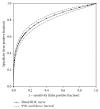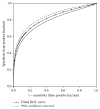Comparison of the Current Diagnostic Criterion of HbA1c with Fasting and 2-Hour Plasma Glucose Concentration
- PMID: 27597979
- PMCID: PMC4997021
- DOI: 10.1155/2016/6195494
Comparison of the Current Diagnostic Criterion of HbA1c with Fasting and 2-Hour Plasma Glucose Concentration
Abstract
To determine the effectiveness of hemoglobin A1c (HbA1c) ≥ 6.5% in diagnosing diabetes compared to fasting plasma glucose (FPG) ≥ 126 mg/dL and 2-hour plasma glucose (2hPG) ≥ 200 mg/dL in a previously undiagnosed diabetic cohort, we included 5,764 adult subjects without established diabetes for whom HbA1c, FPG, 2hPG, and BMI measurements were collected. Compared to the FPG criterion, the sensitivity of HbA1c ≥ 6.5% was only 43.3% (106 subjects). Compared to the 2hPG criterion, the sensitivity of HbA1c ≥ 6.5% was only 28.1% (110 subjects). Patients who were diabetic using 2hPG criterion but had HbA1c < 6.5% were more likely to be older (64 ± 15 versus 60 ± 15 years old, P = 0.01, mean ± STD), female (53.2% versus 38.2%, P = 0.008), leaner (29.7 ± 6.1 versus 33.0 ± 6.6 kg/m(2), P = 0.000005), and less likely to be current smokers (18.1% versus 29.1%, P = 0.02) as compared to those with HbA1c ≥ 6.5%. The diagnostic agreement in the clinical setting revealed the current HbA1c ≥ 6.5% is less likely to detect diabetes than those defined by FPG and 2hPG. HbA1c ≥ 6.5% detects less than 50% of diabetic patients defined by FPG and less than 30% of diabetic patients defined by 2hPG. When the diagnosis of diabetes is in doubt by HbA1c, FPG and/or 2hPG should be obtained.
Figures






References
-
- UKPDS. Intensive blood-glucose control with sulphonylureas or insulin compared with conventional treatment and risk of complications in patients with type 2 diabetes (UKPDS 33). UK Prospective Diabetes Study (UKPDS) Group. The Lancet. 1998;352(9131):837–853. - PubMed
-
- National Diabetes Statistics Report, 2014. 6-22-0014, http://www.cdc.gov/diabetes/pubs/statsreport14/national-diabetes-report-....
-
- Herman W. H., Ye W., Griffin S. J., et al. Early detection and treatment of type 2 diabetes reduce cardiovascular morbidity and mortality: a simulation of the results of the Anglo-Danish-Dutch Study of Intensive Treatment in People with Screen-Detected Diabetes in Primary Care (ADDITION-Europe) Diabetes Care. 2015;38(8):1449–1455. doi: 10.2337/dc14-2459. - DOI - PMC - PubMed
Publication types
MeSH terms
Substances
LinkOut - more resources
Full Text Sources
Other Literature Sources
Medical
Research Materials

